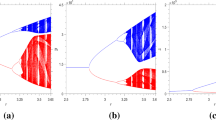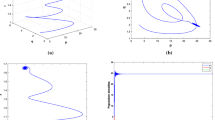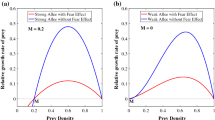Abstract
In ecology, predator–prey interaction is one of the most important factors. The effects of predators on prey population can be direct and deadly, or it may be indirect and non-consumptive. Recent experimental findings have explored that fear of predator (indirect effect) alone can change prey’s behavior including reproduction and foraging. Suraci et al. (Nature Communications, 7, 10698, 2016) experimentally showed that fear of large carnivore reduces mesocarnivore foraging, which benefits the mesocarnivore’s prey. They also showed that fear of large carnivore mediates a cascading effect in lower trophic level. In the present study, our aim is to observe how the cascading effects of fear in a tri-trophic food chain model influence the dynamics of the model. We propose a three-species food chain model incorporating the cost of fear into the predation rate of middle predator. We consider the fact that due to fear of the top predator, middle predator forage less. As a result, the predation rate of middle predator decreases which reduces the predation pressure on basal prey. Mathematical properties such as boundedness, persistence, equilibria analysis, local and global stability analysis of the model are investigated. We perform bifurcation analysis around interior equilibrium point of the system. We notice that cost of the fear in middle predator can stabilize an otherwise chaotic system. We also investigate the robustness of the stabilizing role of the fear parameter. We observe that system initiating from the different dynamical regime, fear ultimately drives the system towards stability. It is also found that for increasing the level of fear, the system enters into a stable state through multiple switching of dynamics. Our results suggest that cost of the fear in middle predator can stabilize the system and enhances persistence of the system. We illustrate our analytical results numerically. Finally our results qualitatively reflect the experimental findings of Suraci et al.










Similar content being viewed by others
Notes
For the generic matrix \(A=(a_{ij},|A|=\displaystyle \max _{\begin{array}{c} 0\le k \le n \end{array}}\sum _{j=1}^{n}|a_{jk}|\) and \(\mu (A)=\displaystyle \max _{1\le k\le n}(a_{kk}+\sum _{j=1(j\ne k)}^{n}|a_{jk}|)).\)
References
Abrams, P.A.: Life history and the relationship between food availability and foraging effort. Ecology 72, 1242–1252 (1991)
Altendorf, K.B., Laundré, J.W., González, C.A.L., Brown, J.S.: Assessing effects of predation risk on foraging behavior of mule deer. J. Mammal. 82, 430–439 (2001)
Barnard, C.J.: Flock feeding and time budgets in the house sparrow (Passer domesticus L.). Nature 28, 295–309 (1980)
Brown, J.S., Laundré, J.W., Gurung, M.: The ecology of fear: optimal foraging, game theory, and trophic interactions. J. Mammal. 80, 385–399 (1999)
Candolin, U.: Reproduction under predation risk and the trade-off between current and future reproduction in the threespine stickleback. Proc. R. Soc. Lond. B Biol. Sci. 265, 1171–1175 (1998)
Cannon, W.B.: Bodily Changes in Pain, Hunger, Fear, and Rage: An Account of Recent Researches into the Function of Emotional Excitement. Read Books Ltd., Appleton (1915)
Coppel, W.A.: Stability and asymptotic behavior of differential equations. Heath (1965)
Creel, S., Christianson, D.: Relationships between direct predation and risk effects. Trends Ecol. Evol. 23(4), 194–201 (2008)
Creel, S., Christianson, D., Liley, S., Winnie, J.A.: Predation risk affects reproductive physiology and demography of elk. Science 315, 960–960 (2007)
Cresswell, W.: Predation in bird populations. J. Ornithol. 152(1), 251–263 (2011)
Das, A., Samanta, G.: Modeling the fear effect on a stochastic prey-predator system with additional food for the predator. J. Phys. A Math. Theor. 51(46), 465601 (2018)
Dhooge, A., Govaerts, W., Kuznetsov, Y.A.: Matcont: a matlab package for numerical bifurcation analysis of odes. ACM Trans. Math. Softw. (TOMS) 29(2), 141–164 (2003)
Hassard, B., Kazarinoff, N., Wan, Y.: Theory and Applications of Hopf Bifurcation, vol. 41. CUP Archive, Cambridge (1981)
Hastings, A., Powell, T.: Chaos in three-species food chain. Ecology 72, 896–903 (1991)
Hua, F., Sieving, K.E., Fletcher, R.J., Wright, C.A.: Increased perception of predation risk to adults and offspring alters avian reproductive strategy and performance. Behav. Ecol. 25, 509–519 (2014)
Hutson, V., Law, R.: Permanent coexistence in general models of three interacting species. J. Math. Biol. 21, 285–298 (1985)
Krebs, J.R., Davies, N.B.: An Introduction to Behavioural Ecology. Sinauer, Sunderland (1981)
Křivan, V.: The lotka-volterra predator-prey model with foraging-predation risk trade-offs. Am. Nat. 170(5), 771–782 (2007)
La Salle, J.: The Stability of Dynamical Systems. SIAM, Bangkok (1976)
Laundré, J.W., Hernández, L., Altendorf, K.B.: Wolves, elk, and bison: reestablishing the ‘landscape of fear’ in yellowstone National Park, USA. Can. J. Zool. 79, 1401–1409 (2001)
Li, M.Y., Muldowney, J.S.: A geometric approach to global-stability problems. SIAM J. Math. Anal. 27(4), 1070–1083 (1996)
Li, M.Y., Wang, L.: A criterion for stability of matrices. J. Math. Anal. Appl. 225(1), 249–264 (1998)
Lima, S., Dill, L.M.: Behavioral decisions made under the risk of predation: a review and prospectus. Can. J. Zool. 68, 619–640 (1990)
Lima, S.L.: Predators and the breeding bird: behavioral and reproductive flexibility under the risk of predation. Biol. Rev. 84(3), 485–513 (2009)
Martin, J., Robert, H.: Logarithmic norms and projections applied to linear differential systems. J. Math. Anal. Appl. 45(2), 432–454 (1974)
Milinski, M., Heller, R.: Influence of a predator on the optimal foraging behavior of sticklebacks (Gasterosteus aculeatus L.). Nature 273, 642–644 (1978)
Panday, P., Pal, N., Samanta, S., Chattopadhyay, J.: Stability and bifurcation analysis of a three-species food chain model with fear. Int. J. Bifurc. Chaos 28, 1850009 (2018)
Pangle, K., Peacor, S., Johannsson, O.: Large nonlethal effects of an invasive invertebrate predator on zooplankton population growth rate. Ecology 88(2), 402–412 (2007)
Peacor, S.D., Peckarsky, B.L., Trussell, G.C., Vonesh, J.R.: Costs of predator-induced phenotypic plasticity: a graphical model for predicting the contribution of nonconsumptive and consumptive effects of predators on prey. Oecologia 171(1), 1–10 (2013)
Preisser, E., Bolnick, D.I., Benard, M.F.: Scared to death? the effects of intimidation and consumption in predator-prey interactions. Ecology 86, 501–509 (2005)
Preisser, E.L., Bolnick, D.I.: The many faces of fear: comparing the pathways and impacts of nonconsumptive predator effects on prey populations. PLoS ONE 3(6), e2465 (2008)
Ripple, W., Beschta, R.L.: Wolves and the ecology of fear: can predation risk structure ecosystems? BioScience 54, 755–766 (2004)
Sasmal, S.K.: Population dynamics with multiple allee effects induced by fear factors-a mathematical study on prey-predator interactions. Appl. Math. Model. 64, 1–14 (2018)
Schmitz, O.J., Beckerman, A.P., Brien, K.M.: Behaviorally mediated trophic cascades: effects of predation risk on food web interactions. Ecology 78, 1388–1399 (1997)
Sih, A.: Optimal behavior: can foragers balance two conflicting demands. Science 210, 1041–1043 (1980)
Sih, A.: Foraging strategies and the avoidance of predation by an aquatic insect, notonecta hoffmanni. Ecology 63, 786–796 (1982)
Suraci, J.P., Clinchy, M., Dill, L.M., Roberts, D., Zanette, L.Y.: Fear of large carnivores causes a trophic cascade. Nat. Commun. 7, 10698 (2016)
Taylor, R.: Predation. Chapman & Hall, New York (1984)
Thieme, H.R.: Mathematics in Population Biology. Princeton University Press, Princeton (2003)
Upadhyay, R., Mishra, S.: Population dynamic consequences of fearful prey in a spatiotemporal predator-prey system. Math. Biosci. Eng. MBE 16(1), 338–372 (2018)
Wang, X., Zanette, L.Y., Zou, X.: Modelling the fear effect in predator-prey interactions. J. Math. Biol. 73(5), 1179–1204 (2016)
Wang, X., Zou, X.: Modeling the fear effect in predator-prey interactions with adaptive avoidance of predators. Bull. Math. Biol. 79(6), 1325–1359 (2017)
Wirsing, A.J., Heithaus, M.R., Dill, L.M.: Living on the edge: dugongs prefer to forage in microhabitats that allow escape from rather than avoidance of predators. Anim. Behav. 74, 93–101 (2007)
Xiao, Y., Chen, L.: Modeling and analysis of a predator prey model with disease in the prey. Math. Biosci. 171, 59–82 (2001)
Zanette, L.Y., White, A.F., Allen, M.C., Clinchy, M.: Perceived predation risk reduces the number of offspring songbirds produce per year. Science 334, 1398–1401 (2011)
Acknowledgements
Pijush Panday’s research work is supported by DST under INSPIRE fellowship programme.
Author information
Authors and Affiliations
Corresponding author
Additional information
Publisher's Note
Springer Nature remains neutral with regard to jurisdictional claims in published maps and institutional affiliations.
Appendix
Appendix
Positivity, Boundedness and Permanence of the system
Positivity
Since the state variables of the system (3) represent population densities, positivity implies that population never become zero and always survive.
Theorem 7.1
All solutions of the system (3) having positive initial values remain positive.
Proof
Let \({R^3_+=[0, \infty )^3}\) be the nonnegative octant in \({R^3}\). The right hand side of the system (3) are continuously differentiable and satisfy locally Lipschitz conditions. So, the solution of the system (3) with nonnegative initial conditions satisfies non negativity condition and uniquely exists in [0, M), where \(M (>0)\) is a sufficiently large number ([39] Theorem A.4). \(\square \)
Boundedness
Boundedness of the predator–prey system means that due to limited resource none of the interacting species of the system grows abruptly or exponentially for a long-time interval.
Theorem 7.2
All the solutions of the system (3) having positive initial conditions in \(R^3_{+}-\{0\}\) are bounded.
Proof
We define a function P which is given by, \(P=x+y+z\).
Differentiating the above equation w.r.t. time along with the solution of (3) is
Therefore, \(\frac{dP}{dt}+\mu P =x(1-x+\mu )-(d_1-\mu )y-(d_2-\mu )z\le \frac{(1+\mu )^2}{4}=Q\)(say), where \(\mu \le min\{d_1,d_2\}\).
We obtain the following inequality by using standard theory of differential inequality
Therefore, as \(t\rightarrow \infty \) we get \(0\le P\le \frac{Q}{\mu }\).
So, all the solutions of system (3) in \(R^3_{+}-\{0\}\), having positive initial conditions are bounded in the region \(W=\{(x,y,z)\epsilon R^3_+:P\le \frac{Q}{\mu }+\eta \), for any \( \eta >0\) }. \(\square \)
Permanence
Persistence of a system implies that the minimal densities of all population are away from zero and bounded. Also all population can coexist for long range of time [16].
Theorem 7.3
Let \(r_1\), \(r_2\), \(r_3\) , \(R_1\), \(R_2\), \(R_3\) are positive constants does not dependent on the initial conditions of system (3). If the subsequent inequalities holds
with initial conditions \(x(0)>0\), \(y(0)>0\), \(z(0)>0\), then we say the system (3) is permanent.
Proof
From system (3) we obtain,
Now applying the standard comparison theorem [44], we get
where \(R_1=1\), \(R_2=\frac{d_2}{a_2}\), \(R_3=\frac{(a_1-d_1)(a_2+b_2d_2)}{a_2^2}\).
Here \(R_1\), \(R_2\) are always positive and \(R_3\) is positive if \(a_1>d_1\). Similarly, from equations (3), we obtain
Similarly using the standard comparison theorem [44], we have
where \(r_1=\frac{a_2-a_1d_2(1+b_2R_2)}{a_2}\), \(r_2=\frac{d_2(1+b_2R_2)}{a_2}\) and
Here, \(r_1, r_2, r_3\) are positive if \(d_1<\frac{a_1a_2-a_1^2d_2(1+b_2R_2)}{a_2+b_1a_2-a_1b_1d_2(1+b_2R_2)}\) and \(d_2<\frac{a_2}{a_1(1+b_2R_2)}.\)
From Eqs. (18) and (20) we conclude that the system (3) is permanent. \(\square \)
Rights and permissions
About this article
Cite this article
Panday, P., Pal, N., Samanta, S. et al. A Three Species Food Chain Model with Fear Induced Trophic Cascade. Int. J. Appl. Comput. Math 5, 100 (2019). https://doi.org/10.1007/s40819-019-0688-x
Published:
DOI: https://doi.org/10.1007/s40819-019-0688-x




